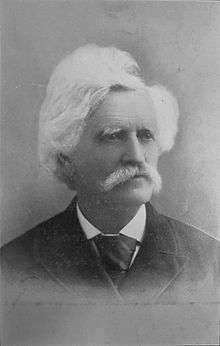H. W. Harkness
Harvey Willson “H.W.” Harkness (May 25, 1821 – July 10, 1901) was an American mycologist and natural historian best known for his early descriptions of California fungal species. Born and raised in Massachusetts and trained as a physician, Harkness came to California during the Gold Rush in 1849. He rose to prominence as physician, educator, real estate developer, and newspaper editor in Sacramento, becoming part of the social circle of early California notables such as Leland Stanford, Charles Crocker, Collis Huntington, and Mark Hopkins. Harkness was a participant in the ceremony marking the completion of the First Transcontinental Railroad, representing California and bearing the Golden Spike that was driven by Leland Stanford marking the completion of the railroad.[1]
H. W. Harkness | |
|---|---|
 | |
| Born | May 25, 1821 |
| Died | July 10, 1901 (aged 80) |
| Nationality | United States |
| Known for | Earliest cataloging of California fungal species |
| Scientific career | |
| Fields | Mycology, Natural history |
| Institutions | California Academy of Sciences |
| Author abbrev. (botany) | Harkn. |
Having earned a large fortune in Sacramento real estate, Harkness retired his medical practice in 1869 and relocated to San Francisco. There, he joined the faculty of the California Academy of Sciences, becoming its president from 1887–1896. He devoted himself to research into the natural history of the Pacific States, publishing articles on the age of the Lassen Cinder Cone[2] and the nature of the fossil footprints discovered near Carson City, Nevada.[3]
The bulk of his research was devoted to cataloging the previously undescribed fungi of California. In the last 30 years of his life, Harkness authored or coauthored a number of papers on California fungi, ranging from simple species lists to a detailed monograph of California hypogeous fungi.
Legacy
- Harkness and his correspondents described scores of fungal species that were new to science. His 1899 monograph, California Hypogeous Fungi, alone described some 55 new species of hypogeous fungi.
- The phytopathogenic ascomycete genus Harknessia is named for him, as are the names of fungal species in 20 genera, as well as several species of vascular plants, including Leptosiphon harknessii.
- Mount Harkness, a mountain near Lassen Peak, is named for him.
- There is an H. W. Harkness Elementary School in Sacramento, California, commemorating his role as first Superintendent of Schools for Sacramento.
- Harkness Street in Sacramento, between 17th and 18th Streets, lies within the 90 acres of land on the southwest corner of what is now Broadway Ave. and Freeport Blvd. that Harkness owned.
References
- Tutorow, Norman E. (2004). "Chapter 6: Building the Central Pacific Rail Road of California—1863–1869". The Governor: The Life and Legacy of Leland Stanford (PDF). Spokane, Washington: Arthur H. Clark Co. p. 292. ISBN 0-87062-326-5.
- How Old is "Cinder Cone"?—Solving a Mystery in Lassen Volcanic Park, California | USGS Fact Sheet at pubs.usgs.gov
- Carson City "Giant Human Tracks" at paleo.cc
- IPNI. Harkn.
External links
- "MycoDigest: Pioneers of California Mycology: HW Harkness" by Peter Werner, Mycena News 57(12):1,4,6, December 2006.
- "The Society's Founders" by Irma West, Sierra Sacramento Valley Medicine 55(2), March/April 2004. (Scroll down to "Harvey W. Harkness, MD, 1821–1901".)